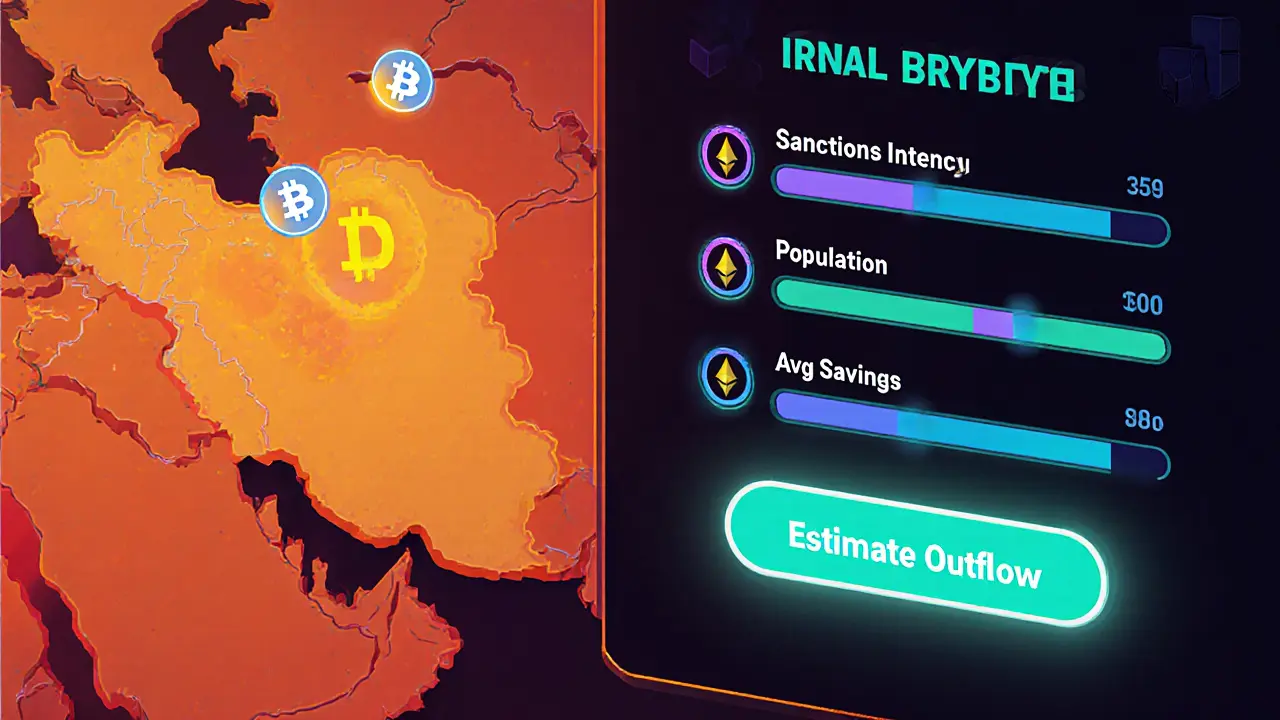Iran Crypto Outflow Calculator
Estimated Annual Crypto Outflow
Enter values and click "Estimate Outflow"
How it works: This calculator estimates potential cryptocurrency outflows based on:
- Inflation rate affects purchasing power loss
- Sanctions intensity impacts access to traditional finance
- Population and average savings determine total potential
$4.18billion cryptocurrency outflows from Iran in 2024 represent a massive surge in digital‑asset capital flight, as documented by Chainalysis. The outflow equals roughly 70% more than the previous year and shows how ordinary Iranians are turning to crypto to protect wealth amid hyperinflation and tightening sanctions.
Key takeaways
- Outflows jumped 70% YoY, reaching $4.18B - about a quarter of all sanctioned crypto activity worldwide.
- Bitcoin accounted for the bulk of transfers; smaller <$1,000 trades fell fastest, indicating a retail‑driven exodus.
- Spikes line up with major geopolitical flashpoints in April and September‑October 2024.
- Iran’s pattern differs from Russia or North Korea: it’s citizen‑led, not state‑orchestrated.
- VPNs, domestic exchanges (Nobitex, Wallex, Ramzinex) and peer‑to‑peer channels were the main access routes.
The scale of the outflow
Chainalysis tracked $4.18billion moving out of Iran’s crypto ecosystem in 2024. That sum equals 26% of the $15.8billion total sanctioned‑entity crypto volume recorded globally that year. To put it in perspective, the amount exceeds Iran’s annual steel export revenue and rivals the total crypto‑related capital flight from Russia in the same period.
Retail investors drove most of the activity. Transactions under $1,000 shrank by 42% on domestic platforms, while larger trades (>$10,000) grew modestly, suggesting that ordinary citizens were converting modest savings into Bitcoin rather than large institutions shifting funds.
Why Iranians turned to crypto
The Iranian rial has lost nearly 90% of its value since 2018, and 2024 inflation hovered between 40‑50%. With official exchange rates frozen and parallel market rates volatile, crypto appeared as a “digital gold” hedge. A survey of Persian‑language Reddit threads showed users describing crypto as the only way to keep savings intact during rial collapse periods.
U.S. sanctions intensified after 2018, cutting off traditional banking channels. The Office of Foreign Assets Control (OFAC) placed Iran on the FATF blacklist, making cross‑border wire transfers expensive or impossible. In that environment, Bitcoin offered a borderless, censorship‑resistant store of value.
Geopolitical triggers and timing
Two clear spikes lined up with international events:
- April9‑14,2024: Israeli airstrike on the Iranian embassy in Damascus and Iran’s retaliatory missile launch. Chainalysis recorded a 28% surge in outbound Bitcoin transfers during this window.
- Late September‑early October2024: Escalated Iran‑Israel clashes. Google Trends showed massive search spikes for “Iran Israel” that mirrored the blockchain data.
During both periods, the rial’s parallel market rate slipped dramatically, prompting citizens to swap rials for Bitcoin in minutes before the next price swing.

What assets were moved?
Bitcoin made up roughly 68% of the outflow volume. Stablecoins (USDT, USDC) accounted for 20%, while the remaining 12% spread across Ethereum, Litecoin and smaller altcoins. The dominance of Bitcoin reflects its deep liquidity and familiarity among Iranian traders.
When domestic exchanges like Nobitex and Wallex were forced to shut down in November‑December 2024, users pivoted to peer‑to‑peer networks and VPN‑routed access to global platforms such as Binance and Kraken.
Comparing Iran with other sanctioned economies
| Country | Outflow Volume (USD) | Main Drivers | Typical Transaction Size | Dominant Asset |
|---|---|---|---|---|
| Iran | $4.18B | Retail capital flight, hyperinflation, sanctions | Under $1,000 (retail) | Bitcoin |
| Russia | $3.2B | State‑level evasion, export financing | > $10,000 (institutional) | Ethereum |
| Venezuela | $1.4B | Hyperinflation, oil sanctions | Mixed | Stablecoins |
| North Korea | $0.9B (estimated) | State‑sponsored hacking & theft | Large, illicit transfers | Monero & Bitcoin |
The table shows Iran’s outflows are larger per‑capita than Russia’s and far exceed Venezuela’s despite similar economic distress. Unlike North Korea’s covert operations, Iran’s flow is openly discussed on Persian forums, indicating a grassroots shift.
How Iranians actually move crypto
Because most international exchanges block IPs linked to Iran, users rely heavily on VPNs and proxy services. Chainalysis notes a 65% increase in VPN‑routed traffic from Iranian IP ranges in 2024.
Domestic platforms-Nobitex, Wallex, Ramzinex-once offered on‑ramp services without KYC, but new licensing rules in early 2024 forced them to collect full user data. When the government cracked down on these exchanges in late 2024, many operators migrated their order books to offshore servers, allowing users to continue trading via encrypted messaging apps.
Community‑run Telegram channels (over 100k members combined) share seed phrases, VPN recommendations, and “bridge” services that convert Bitcoin into peer‑to‑peer stablecoins for cross‑border remittances. Expatriates also use crypto to fund tuition or send money home, bypassing the expensive, sanction‑laden SWIFT system.
Implications for sanctions and the global crypto market
Iran’s outflow highlights a growing blind spot in traditional financial sanctions. While the U.S. Treasury’s 2025 National Security Presidential Memorandum tightened monitoring of Iranian‑linked wallets, the decentralised nature of Bitcoin made complete blockage impossible.
Compliance costs for global exchanges jumped 45% in 2024 as they upgraded blockchain analytics tools. Yet, the sheer volume of retail‑level transfers means that many small‑scale users slip through the net, preserving wealth while still violating sanctions.
For policymakers, Iran serves as a case study of how hyperinflation and sanctions together accelerate crypto adoption. The “alternative financial system” described by Chainalysis suggests that future sanction regimes may need to address the underlying economic triggers, not just the technology.
Future outlook
Chainalysis projects continued growth in Iranian crypto activity through 2025‑2026, especially as the rial remains weak and geopolitical tensions persist. Iran’s partnership with Russia on crypto‑facilitated trade could institutionalise the practice, moving it beyond the current retail‑driven phase.
At the same time, emerging privacy‑enhancing protocols (e.g., Taproot‑enabled Bitcoin, confidential transactions) could make tracing harder, while international regulatory coordination through the G7 and FATF aims to close loopholes. The tug‑of‑war between compliance tools and user ingenuity is likely to define the next chapter of crypto‑based sanctions evasion.

Frequently Asked Questions
What caused the $4.18billion outflow?
A combination of hyperinflation, a collapsing rial, and tighter U.S. sanctions pushed ordinary Iranians to convert savings into Bitcoin and other crypto assets as a hedge.
Which crypto was most used?
Bitcoin dominated, making up about 68% of the total outflow volume. Stablecoins were the next biggest segment at roughly 20%.
How did users bypass exchange bans?
Most relied on VPNs and proxy services to reach global platforms. Domestic exchanges that stayed open before the crackdown also facilitated trades, often through peer‑to‑peer Telegram networks.
Is Iran’s crypto activity similar to Russia’s?
Both countries use crypto to evade sanctions, but Iran’s flow is largely retail‑driven, while Russia’s is more institutional and focuses on Ethereum for trade financing.
Will sanctions eventually stop the outflow?
Complete blockage is unlikely. As long as the rial stays weak and international payment routes stay restricted, crypto will remain an attractive alternative, even if compliance costs rise.
Iran crypto outflows have reshaped how analysts view sanctions effectiveness in the digital age. The data shows a clear pattern: economic desperation fuels crypto adoption, and geopolitics amplifies it. Understanding these dynamics helps policymakers, investors, and compliance teams anticipate the next wave of digital‑asset‑based capital flight.







Jenae Lawler
February 4, 2025 AT 19:34It must be noted that attributing every capital flight to cryptocurrency oversimplifies a multifaceted economic phenomenon; the interplay of sanctions, domestic monetary policy, and private wealth strategies cannot be reduced to a singular digital conduit.
Chad Fraser
February 11, 2025 AT 08:00Hey folks, the numbers are eye‑opening, but they also show how resilient people can be when they rally behind new tech – keep learning, keep adapting, and you’ll ride these waves!
Jayne McCann
February 17, 2025 AT 20:56Sure, crypto looks shiny, but it’s not the only place cash disappears.
Richard Herman
February 24, 2025 AT 09:53When you look at the broader picture, the outflow reflects both a search for financial autonomy and a reaction to tightening external pressures; it’s a mixed signal that deserves nuanced discussion.
Parker Dixon
March 2, 2025 AT 22:50Interesting data! The calculator gives a tangible sense of scale, but remember real‑world behavior is messier – people move money in stages, use offshore accounts, and sometimes blend crypto with traditional assets. 😎
That said, the $4.18 B figure does highlight a growing appetite for alternatives.
Stefano Benny
March 9, 2025 AT 11:46From a macro‑risk perspective, the crypto exodus is a symptom of liquidity strain, not a novel invention; the same capital would find a way out via informal hawala channels if the blockchain were blocked. 🤖
Bobby Ferew
March 16, 2025 AT 00:43Honestly, I feel the sheer panic in these numbers – it’s like watching a financial horror movie where every protagonist thinks they’re safe until the next block‑height hits.
celester Johnson
March 22, 2025 AT 13:40One could argue that the flight to crypto mirrors a deeper existential crisis: the quest for sovereignty in a world where nation‑states increasingly dictate financial destiny.
Prince Chaudhary
March 29, 2025 AT 02:36I appreciate the effort to quantify the outflow; it’s a useful tool for analysts, provided we keep in mind the assumptions behind the sliders.
John Kinh
April 4, 2025 AT 15:33Data looks inflated.
Mark Camden
April 11, 2025 AT 04:30While the calculator is informative, treating $4.18 B as a monolithic “crypto outflow” ignores the layers of informal finance and shadow banking that have historically absorbed similar capital flows.
Evie View
April 17, 2025 AT 17:26Your optimism is charming, but the reality is ruthless – aggressive capital moves rarely care about sentiment; they care about survival.
Kate Roberge
April 24, 2025 AT 06:23Honestly, this is just hype; you’ll see the same numbers tomorrow when another crisis hits elsewhere.
Jacob Anderson
April 30, 2025 AT 19:20Oh sure, because sliding a couple of bars on a webpage magically explains complex geopolitics. 🙄
Kate Nicholls
May 7, 2025 AT 08:16Let’s not pretend this model captures the full picture; it’s a simplification at best.
Carl Robertson
May 13, 2025 AT 21:13Drama aside, the numbers are a symptom of a larger narrative-people fleeing not just money but also fear of a collapsing system.
Rajini N
May 20, 2025 AT 10:10From a policy standpoint, the slider model is a great educational aid, yet analysts should supplement it with on‑ground intelligence for accurate forecasts.
Sidharth Praveen
May 26, 2025 AT 23:06The surge in crypto usage among Iranian citizens is a testament to human ingenuity when faced with economic adversity; it showcases how digital assets can serve as a hedge against inflation and oppressive financial restrictions.
Sophie Sturdevant
June 2, 2025 AT 12:03Exactly, and that's why we need to talk about how aggressive adoption can also spur domestic innovation; the market will reward those who adapt quickly.
Nathan Blades
June 9, 2025 AT 01:00Philosophically, the shift toward decentralized finance raises questions about the social contract between citizens and the state; when trust erodes, technology fills the vacuum.
Somesh Nikam
June 15, 2025 AT 13:56Good point. 😊 Also, community education will be key to preventing scams as more people jump onto the crypto bandwagon.
Jan B.
June 22, 2025 AT 02:53The figure of $4.18 billion certainly commands attention, yet a deeper dive reveals several layers that merit careful unpacking.
First, the raw number does not differentiate between short‑term speculative transfers and long‑term asset preservation strategies.
Second, many of these transactions likely traverse multiple exchanges, mixing services, and peer‑to‑peer platforms, obscuring the final destination of the funds.
Third, the impact of sanctions on traditional banking channels has forced a segment of the population to explore alternative routes, but not all of them settle on public blockchains.
Fourth, the presence of offshore entities and shell companies adds another veil of complexity that any quantitative model must treat as an external variable.
Fifth, inflationary pressures within Iran spur households to diversify, but the decision matrix includes factors such as digital literacy, access to reliable internet, and trust in custodial services.
Sixth, the role of the diaspora cannot be ignored; remittances often flow through crypto as a low‑cost conduit, inflating the apparent outflow numbers.
Seventh, market volatility plays a dual role: it can both attract capital seeking high returns and repel risk‑averse savers during downturns.
Eighth, the regulatory response from neighboring jurisdictions influences the ease of converting crypto back into fiat, thereby shaping the net outflow.
Ninth, geopolitical dynamics, such as shifting alliances and new sanction regimes, continually reshape the incentive landscape.
Tenth, data collection limitations, including under‑reporting and the anonymity of wallets, introduce a margin of error that should temper our conclusions.
Eleventh, the psychological component-fear of devaluation and desire for financial sovereignty-drives behavior beyond pure economic rationality.
Twelfth, there is evidence that a portion of the capital is being redeployed into other emerging markets, creating a secondary ripple effect.
Thirteenth, the growth of decentralized finance (DeFi) platforms offers new yield‑generation opportunities, further diversifying the outflow purpose.
Fourteenth, as the ecosystem matures, institutional players may enter, potentially stabilizing the flow patterns.
Finally, policymakers should consider these multifaceted drivers before crafting responses, ensuring that any measures address both the symptoms and the underlying causes.
MARLIN RIVERA
June 28, 2025 AT 15:50The analysis ignores the obvious fact that crypto prices are speculative bubbles.
Debby Haime
July 5, 2025 AT 04:46Great breakdown! It’s clear that a one‑size‑fits‑all explanation won’t cut it, and continued dialogue will help us all stay informed.